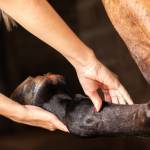Treating Tendon Disease in Horses with Stem Cells: A Controlled Trial

Stem cell therapy for tendon injuries is now a common procedure, embraced by veterinarians and owners alike. Despite the popularity of the procedure, there is little evidence-based data collected from controlled clinical trials. In fact, there are no studies in which treated horses are compared to untreated horses. Without controlled studies, we are left not knowing whether stem cell treatment is truly more effective than other therapies, such as a controlled exercise rehabilitation program.
Veterinary researchers recently found a way to circumvent the problem of not having a control group. In that study, Burk and coworkers recruited 14 client-owned horses with naturally occurring tendon disease.* Seven horses were treated with adipose-derived allogeneic stem cells suspended in serum and the remaining seven horses were treated with serum alone.
The following few points should be noted regarding this study design:
- Serum was used as the vehicle to deliver the stem cells and in the control group. Blood products (e.g., IRAP or autologous conditioned serum) display beneficial effects on tendon healing. Thus, the control group was not considered fully untreated.
- Adipose-derived allogeneic stem cells were collected from a single healthy donor. Adipose tissue was selected rather than bone marrow based on previous study results.
“Also note, allogenic stem cells rather than autologous (using the patient’s own stem cells) were selected because using off-the-shelf stem cells shortens the time interval between the injury and time of first regenerative treatment,” explained Catherine Whitehouse, M.S., of Kentucky Equine Research.
After treatment, all horses participated in a controlled rehabilitation program consisting of 16 weeks of walking (that increased gradually from five to 40 minutes) and then 16 weeks of additional training at a trot (increasing from five to 20 minutes while decreasing time walking). The final 16 weeks involved exercising horses 45 minutes daily and gradually increasing galloping exercise.
“Key findings were that inflammation, lameness, and ultrasonography scores all had a greater improvement in the group of horses treated with stem cells. Improvement in lameness was observed after six months,” Whitehouse said.
In terms of long-term follow-up, five of the seven horses in the stem cell group remained free of re-injury at 12 and 18 months. In contrast, only three of seven horses in the control group were free of re-injury at 12 months.
In conclusion, the researchers wrote, “to the best of our knowledge, this is the first controlled study investigating the efficacy of allogeneic MSCs (stem cells) in naturally occurring tendon disease objectively with long-term follow-up during rehabilitation training.”
Athletic horses that suffer tendon injuries often have sudden lay-ups and slowly resume work, as described above with the rehabilitation program.
“Horses on stall rest or restricted turnout due to injury often require dietary modifications to manage their weight and behavior. Plus, soft-tissue health and repair can be supported by high-quality trace minerals, vitamins such as vitamin C, and omega-3 fatty acids. Kentucky Equine Research offers several products ideal for supporting the recovery of the convalescing horse,” advised Whitehouse.
*Burk, J., L. Wittenberg-Voges, S. Schubert, C. Horstmeier, W. Brehm, and F. Geburek. 2023. Treatment of naturally occurring tendon disease with allogeneic multipotent mesenchymal stromal cells: A randomized, controlled, triple-blinded pilot study in horses. Cells 12(21):2513.








